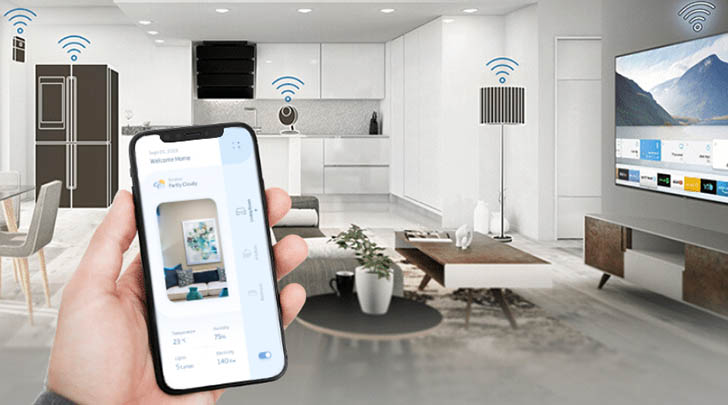
Understanding Smart Home Sensors: Your Key to a Smarter Home
In today’s rapidly evolving world, where technology is seamlessly integrated into our daily lives, Understanding smart home sensors becomes fundamental. These sensors are the backbone of modern home automation, offering convenience, security, and efficiency. For home enthusiasts eager to transform their living spaces into intelligent sanctuaries, comprehending how these sensors function is essential.

What Are Smart Home Sensors?
Smart home sensors are devices designed to detect and respond to various inputs from the physical environment. These inputs can range from motion and temperature changes to humidity levels and light intensity. The information gathered by these sensors is transmitted to a central hub or directly to your smartphone, enabling real-time monitoring and control of your home environment.
The Role of Smart Home Sensors in Home Automation
When you think about a smart home, sensors are likely at the core of its operation. They act as the eyes and ears of your home automation system, providing the data necessary for informed decision-making. Whether it’s adjusting your thermostat based on the room’s occupancy or turning on lights when you enter a room, sensors make these automated tasks possible.
Types of Smart Home Sensors
Understanding the different types of smart home sensors is crucial for selecting the right ones for your needs. Here are a few common types:
- Motion Sensors: Detect movement within a specified range.
- Temperature Sensors: Monitor and report the temperature of a room.
- Humidity Sensors: Measure the moisture level in the air.
- Light Sensors: Adjust lighting based on the amount of natural light available.
- Door/Window Sensors: Alert you when doors or windows are opened.
Benefits of Smart Home Sensors
The integration of smart home sensors offers numerous advantages, enhancing both comfort and security:
Energy Efficiency
By using sensors to regulate heating, cooling, and lighting, you can significantly reduce energy consumption. For example, a smart thermostat can adjust temperatures based on whether a room is occupied or not, leading to substantial energy savings.
Enhanced Security
Security is a top priority for many homeowners. Smart home sensors contribute significantly to security systems by detecting unauthorized access and alerting homeowners instantly. Motion sensors, door/window sensors, and smart cameras work together to safeguard your home.
Convenience and Comfort
Imagine waking up to a home that automatically adjusts the temperature, opens the curtains, and plays your favorite morning playlist. Sensors make this level of convenience possible, adapting your environment to your preferences seamlessly.
Integrating Smart Home Sensors
Integration is key to maximizing the benefits of smart home sensors. Here are some steps to ensure effective integration:
Choose Compatible Devices
Ensure that the sensors you choose are compatible with your existing home automation system. Compatibility ensures smooth communication between devices, enhancing their overall efficiency. For insights, check out this guide on smart home hubs.
Proper Placement
The placement of sensors is crucial for optimal performance. Motion sensors, for instance, should be positioned in areas with high foot traffic, while temperature sensors should be placed away from direct sunlight or heat sources.
Regular Maintenance
Regular maintenance ensures that your sensors function correctly. Dust and debris can interfere with sensor accuracy, so periodic cleaning is recommended. For more maintenance tips, visit smart home maintenance.
Common Challenges and Solutions
While smart home sensors offer numerous benefits, they also come with challenges. Here are some common issues and solutions:
Connectivity Issues
Intermittent connectivity can disrupt sensor performance. To address this, ensure your Wi-Fi network is robust and consider using a dedicated smart home hub for improved connectivity.
False Alarms
False alarms can be a nuisance. Regularly calibrate your sensors and adjust sensitivity settings to minimize false alerts.
Battery Life
Many sensors are battery-powered. Monitor battery levels and replace them as needed to ensure uninterrupted operation.
The Future of Smart Home Sensors
The future of smart home sensors is bright, with continuous advancements in technology. Innovations such as AI integration and enhanced data analytics promise even smarter and more intuitive home environments. To learn more about the future of AI in smart homes, visit AI in smart home systems.
Conclusion
Understanding smart home sensors is crucial for anyone looking to embrace home automation fully. These sensors enhance the way we interact with our living spaces, providing convenience, security, and efficiency. By staying informed about the types of sensors available, their benefits, and best practices for integration, you can create a smarter home that meets your unique needs and preferences.

FAQs
What are the most common types of smart home sensors?
The most common types of smart home sensors include motion sensors, temperature sensors, humidity sensors, light sensors, and door/window sensors.
How do smart home sensors contribute to energy efficiency?
Smart home sensors contribute to energy efficiency by optimizing heating, cooling, and lighting based on real-time data, reducing unnecessary energy consumption.
Can smart home sensors improve home security?
Yes, smart home sensors enhance home security by detecting unauthorized access and alerting homeowners, often integrating with other security devices like cameras and alarms.
This article contains affiliate links. We may earn a commission at no extra cost to you.